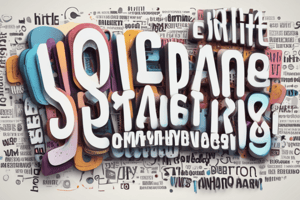Podcast
Questions and Answers
Which punctuation mark is used to join two independent clauses or to separate items in a list with commas?
Which punctuation mark is used to join two independent clauses or to separate items in a list with commas?
- Exclamation mark
- Semicolon (correct)
- Period
- Comma
In the sentence 'She ___________ her friend's advice and decided to pursue her dreams.', which verb correctly agrees with the subject?
In the sentence 'She ___________ her friend's advice and decided to pursue her dreams.', which verb correctly agrees with the subject?
- ignore
- ignoring
- ignored
- ignores (correct)
Which of the following sentences correctly uses parallel structure?
Which of the following sentences correctly uses parallel structure?
- 'To read, writing, and grammar are skills that can be improved.'
- 'The company will expand into new markets, hiring additional staff, and invest in research.' (correct)
- 'He likes running, swimming, and to ride a bike.'
- 'She was happy, excited, and that she will be successful.'
Which tense is used to describe ongoing, habitual, or general actions that are not limited to a specific time frame?
Which tense is used to describe ongoing, habitual, or general actions that are not limited to a specific time frame?
Which punctuation mark is used to separate items in a list, prevent misinterpretation, and create pauses in sentences?
Which punctuation mark is used to separate items in a list, prevent misinterpretation, and create pauses in sentences?
Which of the following sentences properly demonstrates parallel structure?
Which of the following sentences properly demonstrates parallel structure?
Which statement accurately explains the concept of a sentence fragment?
Which statement accurately explains the concept of a sentence fragment?
In the sentence 'The team __ at the stadium,' which verb correctly demonstrates subject-verb agreement?
In the sentence 'The team __ at the stadium,' which verb correctly demonstrates subject-verb agreement?
What is the correct verb agreement for the sentence 'One of the students __ an award yesterday'?
What is the correct verb agreement for the sentence 'One of the students __ an award yesterday'?
Which of the following sentences demonstrates proper use of tense consistency?
Which of the following sentences demonstrates proper use of tense consistency?
Study Notes
The Art of Effective Writing: Mastering Punctuation, Tense, and More
In the world of writing, nailing down the basics is key to crafting clear, competent, and compelling texts. In this article, we'll dive into some fundamental rules and best practices related to punctuation, tenses, and other crucial writing conventions that will help you polish your prose.
Punctuation: The Secret to Clarity
Punctuation serves as a guide for readers, helping them understand the intended meaning of a sentence. Three common marks to master are the period, comma, and semicolon:
- A period (.) is used to end a sentence, indicating a break between ideas.
- A comma (,) is used to separate items in a list, prevent misinterpretation, and create pauses in sentences.
- A semicolon (;) is used to join two independent clauses, or to separate items in a list when the items themselves already contain commas.
Tenses: Keeping Time Straight
Tenses are critical for communicating the time frame of your writing. Three primary tenses to be aware of are:
- The present simple tense (e.g., I walk to work) describes ongoing, habitual, or general actions that are not limited to a specific time.
- The past simple tense (e.g., I walked to work) is used to describe completed actions in the past.
- The future simple tense (e.g., I will walk to work) describes actions that will happen in the future.
Sentence Fragments: Putting them in Their Place
A sentence fragment is a group of words that is not a complete sentence because it does not express a complete thought. To determine if a group of words is a sentence fragment, ask: "Can this group of words stand alone as a complete sentence?" If the answer is no, it's a fragment, and you'll need to revise it or combine it with another sentence to create a complete thought.
Parallel Structure: Keeping it Consistent
Parallel structure means using similar grammatical structures in a series of items to create balance and clarity. For example, when listing items, you should use the same verb form or word type:
- I like to hike, bike, and swim for exercise. (Verb form: to + infinitive)
- I enjoy hiking, biking, and swimming. (Verb form: present simple tense)
- Hiking, biking, and swimming are my favorite activities. (Noun form: activities)
Verb Agreement: Keeping Verbs in Sync
Verb agreement is the use of a verb form that matches the subject in number and person. Incorrect verb agreement creates confusion and can make your writing appear unprofessional. To ensure proper verb agreement, always ensure the verb agrees in number and person with its subject:
- The cat enjoys its favorite toy. (Cat is singular, so the verb is in the singular form.)
- The cats enjoy their favorite toys. (Cats is plural, so the verb is in the plural form.)
With a firm grasp of these fundamental writing conventions, you'll be well on your way to crafting clear, engaging stories, essays, and more. Happy writing!
Studying That Suits You
Use AI to generate personalized quizzes and flashcards to suit your learning preferences.
Description
Test your knowledge on essential writing elements such as punctuation, tenses, sentence fragments, parallel structure, and verb agreement. Enhance your understanding of these fundamental rules to improve the clarity and professionalism of your writing.




